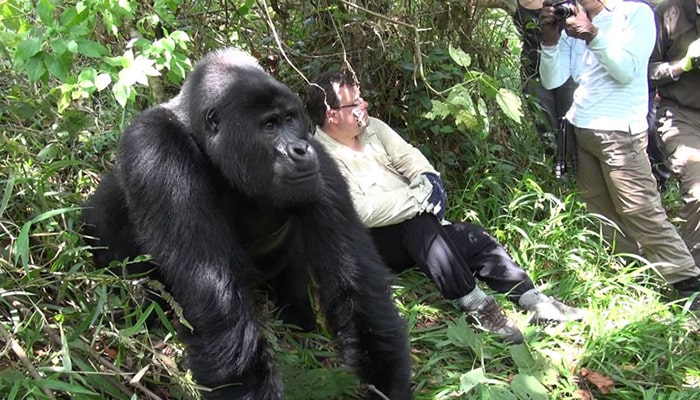Bwindi Mountain Gorillas Increase in Numbers – There is a General Rise in World Gorilla Populations
The endangered Bwindi Mountain gorillas have increased in numbers, thanks to the conservation efforts by the various wildlife stakeholders. According to the latest data, Bwindi Impenetrable National Park has seen its gorilla numbers rise from 400 in 2011 to 459 gorillas todate.
The good news of the surge in numbers of the endangered primate species was revealed by the outgoing Uganda Minister of Tourism Wildlife and Antiquities, Prof. Ephrahim Kamuntu, this week. This was at a function to unveil the mountain gorilla populations in the Greater Virunga Conservation Area. At the event, the long-awaited global numbers of the endangered gorillas in Uganda, Rwanda and the Democratic Republic of Congo were realesed showing a steady growth in the gorilla demographics.
In the whole world, mountain gorillas only live in Bwindi forest and Mgahinga Gorilla National Park in Uganda. You can also trek gorillas in the Volcanoes National Park in Rwanda and Virunga National Park in Congo.
The data release was presented in collaboration with the Greater Virunga Trans boundary and Bwindi-Sarambwe Ecosystem manifested that the number of gorillas (gorilla beringei) in the 340 square kilometer boundary of protected forest to have gone up to 459 in 50 groups and 13 from about 400 in 2011.
Putting together the published outcome of the Virunga Mastiff 2015/16 Survey of 604, the worldwide mountain gorilla numbers are 1,063 at the present. Uganda’s gorillas that dwell in Bwindi Impenetrable forest and Mgahinga Gorilla National Park now stand at about 51% of the total numbers of the worldwide endangered species with an estimated 49% shared between Rwanda and Congo.
Joseph Arinitwe, the Warden of the Ecological Monitoring and Research Bwindi-Mgahinga Conservation Area (BMCA) said that the process began from the eastern edge of the forest to Sarambwe Nature Reserve in the western side.
It entailed over 75 trained survey members in 6 teams in 250 to 500-meter stretches with the support of local governments and communities near the protected zones. They moved at standard intervals at agreed times in shifts of 2 weeks each gathering elephants, duikers plus gorillas fecal matter from fresh nests where the samples were put together and kept for genetic analysis. Indicators of human activity were also studied. The team persevered through challenging rugged terrain, floods, twigs, and insect bites.
Arinitwe asserted that the surveys were vital in monitoring trends and confirm that indeed conservation strategies are effective.
Dr. Pantaleon Kasoma who spoke on behalf of the Uganda Wildlife Authority (UWA) Board of Trustee emphasized the value of gorilla revenues which he said was higher compared to other segments of the tourism sector.
The State Minister for Tourism Godfrey Kiwanda applauded Prof. Kamuntu for his attempts to turn around Human Wildlife Conflict into Human Wildlife Relationship by moving around Uganda to educate communities surrounding the National Parks and Wildlife corridors plus revenue sharing.
Kamuntu welcomed the new Tourism Minister Tom Butime. The Japanese Ambassador to Uganda Kazuaki Kameda, Permanent Secretary MTWA Doreen Katusime; Director of Tourism James Lutalo, Dr. Andrew Seguya, Executive Secretary at Greater Virunga Trans boundary Collaboration, Dr. Gladys Kalema, Conservation Through Public Health (CTPH), Executive Director UWA, Sam Mwanda, Director of Business Services UWA, Stephen Masaba, Professor Robert Bitariho of Mbarara University plus members from the Institute of Tropical Forest Conservation (ITFC) and researchers were in attendance.
Kamuntu lauded international organizations for putting gorillas to the attention of humanity. He said if it wasn’t their efforts, the gorillas would have been wiped out. The credited bodies include International Gorilla Conservation Program (IGCP), Institut Congolais pour la Conservation de la Nature (ICCN), Rwanda Development Board (RDB) and the Institute of Tropical Forest Conservation (ITFC). Others included the Wildlife Conservation Society (WCS), Conservation Through Public Health (CTPH), Diane Fossey Gorilla Fund, World Wildlife Fund (WWF), Bwindi Mgahinga Conservation Trust (BMCT) and the gorilla Doctors among others.
Kamuntu said the increase in the gorilla numbers and wildlife in general was an indicator of a positive path to development surpassing pre-independence numbers.

